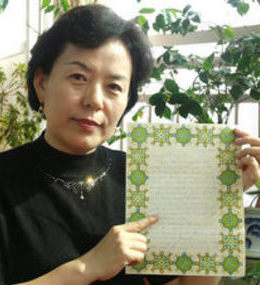 |
|
Kim Myeong-ja holds a letter which she received in 1975 from her ”adoptive” mother.
|
Kim Myeong-ja calls support she received a ’beautiful debt’
"When I heard that Mother in the United States passed away, I was so sad." Kim Myeong-ja, 52, whom I met at her house in Daegu on October 29, still mourns the death of her "other mother," a woman with blue eyes, Jean Herlin, who passed away in July this year. She talks about Herlin candidly by the side of her birth mother and the woman who raised her, Kim Hyo-rye, 78. The 40-year relationship she had with her ‘adoptive’ mother awakened in her the warmth of the world: Kim Myeong-ja said, "When my other mother was alive, the U.S. seemed like a full country, but now the nation seems empty." Kim came to know her ‘adoptive’ mother around 1962, when she entered elementary school at the age of nine. Kim, who had lost her father when she was very young, lived a hardscrabble existence with her mother in Wonhyoro, Yongsan-gu, Seoul. "When most people went without a meal," Herlin offered help for her family. An international organization to aid children introduced Herlin to Kim Myeong-ja, and Herlin donated money to provide daily necessities for the family. Thanks to Herlin, Kim could pay her school fees and have some pocket money left over.But the aid plan had a regulation under which those of high school senior age could no longer receive support. Kim, who entered elementary school one year later than most other students, was going to lose the support when she was a second-year student at a Seoul high school. Herlin, however, who had come to know of Kim’s situation, continued to help her personally. Even though Kim experienced hard times throughout her life, the self-made woman wanted to meet Herlin. Herlin sent Kim two airplane tickets in 1994, so Kim set off to visit the U.S. with her husband. When she met Herlin, Kim was wearing an elegant traditional Korean hanbok; she bowed deeply to the ’mother’ she was meeting for the first time. It was a meeting of two hearts that had formed a connection across the Pacific. Now Herlin has passed away, but the seeds of hope sowed by her are being carried by Kim. Kim, who owns a business in Daegu, acts as a Jean Herlin to Tsion Assfa in Ethiopia and Hoang Mai in Vietnam, sending them money every month. Her husband and her eldest daughter also support one foreign child each. "To help foreign kids who are facing hardship is a process of repaying the ’beautiful debt’ that I owe," Kim said. "I think that it is not simply to provide financial support, but to open those children’s thoughts and mind and to foster their dreams." The number of people who extend their helping hand to children overseas has increased dramatically every year. According to the estimate by the Korea NGO Council for Overseas Cooperation (KCOC), the association of 48 Korean nongovernmental organizations working overseas, regular sponsorship, most of which is comprised of membership fees paid by individuals, increased to about 45 billion won (US$46 million) in 2004 from 19 billion won in 2000. Today’s tendency is that an increased number of people are becoming aware of the need to lend their hand to nations overseas, supporting businesses such as medical services and regional development, as well as providing support for the children. To help children in Africa, Southeast Asia, and other places in the world, children who go to bed hungry in an unhygienic environment, is not a complicated procedure. By simply logging on to the Internet sites of the NGOs listed above and making a telephone call, you can be a creditor of a "beautiful debt."





